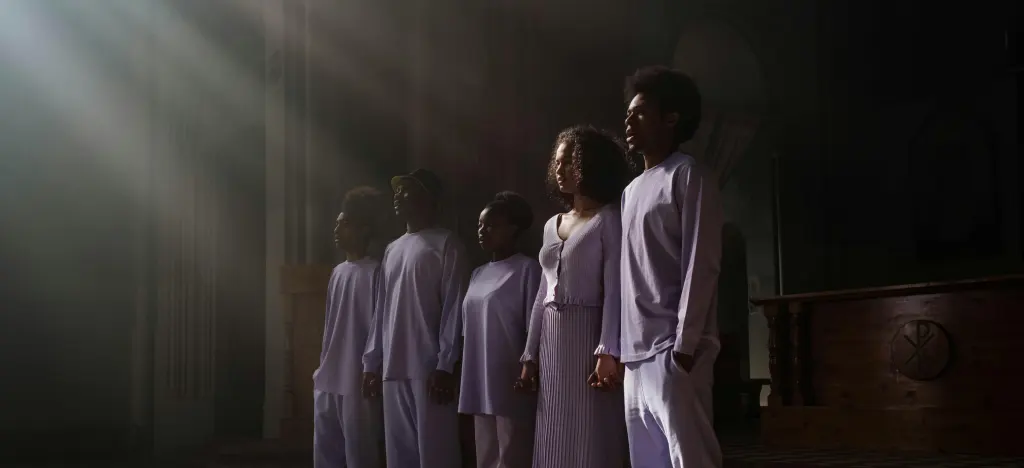Think music theory is just for classical musicians or academics? Think again. A basic knowledge of theory can make a big difference to your songwriting, helping you craft catchier melodies, powerful chord progressions, and lyrics that really gel with your tunes. Whether you’re just starting out or have been writing for years, using music theory can give your songs that extra edge.
- What is music theory?
- Using music theory to create more engaging melodies
- Melody writing walkthrough
- Understanding chord progressions
- Free video lesson on chord progressions
- Harmonies in songwriting
- Tips for writing lyrics that fit your music
- Examples from popular songs
- Learn music theory for free
What is music theory?
Music theory is the study of how music works. It explains the structure behind melodies, harmonies, rhythms, and other musical elements. By understanding music theory, you learn the "rules" and patterns that make music sound good — things like scales, chord progressions, time signatures, and key signatures. Think of it like a toolkit that helps you understand why certain combinations of notes, chords, and rhythms work together to create music, making it easier to write, analyze, or perform songs.
However, it's not just about rules— it's also about giving you the tools to creatively break them when needed!
Let's take a look at some practical ways you can use elements of music theory to improve your songwriting skills, from creating melodies to chord progressions, harmonies and lyrics.
► ARTMASTER TIP: It's easy to get lost in music terminology. So, we've put together a glossary of terms from the basics and beyond — Comprehensive guide to music terms.
Using music theory to create more engaging melodies
 Melody is at the heart of songwriting. It’s what gets stuck in your head and tugs at your emotions. But what makes a melody truly memorable? That’s where music theory comes in.
Melody is at the heart of songwriting. It’s what gets stuck in your head and tugs at your emotions. But what makes a melody truly memorable? That’s where music theory comes in.
Here are 8 tips you can try out to create engaging and memorable melodies:
1. Start with a scale to set the mood
Choose a scale: Start by picking a scale that fits the mood you want to convey. If you’re aiming for something upbeat and happy, use a major scale like C major. If you’re going for something more introspective or sad, a minor scale like A minor might fit better.
Example: "Let It Be" by The Beatles is in the key of C major.
Tip: Play through the notes of the scale on your instrument to get a feel for its vibe. Then, start improvising a simple melody using just those notes.
2. Experiment with melodic movement
Use stepwise motion: Create a basic melody by moving between adjacent notes in the scale (like C-D-E). This type of motion is smooth and easy for listeners to follow.
Tip: Try singing or playing a stepwise melody and notice how it feels natural and connected. Use this as the foundation for your melody.
Add leaps for interest: Introduce larger intervals (leaps) to add contrast and excitement (like C to G). This makes the melody more dynamic.
Example: "Somewhere Over the Rainbow" by Judy Garland begins with a leap of an octave, which grabs attention.
Tip: Start with a stepwise melody, then add a leap in a key place, such as at the end of a phrase or to highlight an important word or emotion.
3. Play with phrase length and structure
Craft phrases: Think of your melody as a series of phrases — musical sentences. A common structure is to create a “call and response,” where one phrase asks a question and the next answers it.
Tip: Write two phrases where the first ends on a note that feels unresolved (like the 2nd or 5th note of the scale), and the second phrase resolves it (landing on the root note or 3rd).
4. Use repetition with variation
Develop a motif: Start with a short, catchy motif—a sequence of a few notes—and repeat it throughout your melody. Slightly vary it each time to keep it interesting.
Tip: Write a 4-note motif and repeat it several times, each time changing one aspect, like the rhythm or the ending note.
5. Introduce tension and release
Dissonance and resolution: Use notes that create tension (dissonant notes) and resolve them to more stable notes (consonant notes). This creates a satisfying journey in your melody.
Example: "Billie Jean" by Michael Jackson features a syncopated rhythm that creates tension in the verses, which is released in the more straightforward and catchy chorus.
Tip: Play a note that doesn’t belong to the current chord, then resolve it to a chord tone. Notice the tension and release this creates.
Syncopation: Add syncopation—accenting the off-beats—to make the rhythm of your melody more compelling.
Tip: Take a simple melody and shift some of the notes so they fall on the off-beats. Clap or tap along to get a feel for how it changes the groove.
6. Use chromaticism sparingly
Add colour with chromatic notes: Introduce a note outside the scale briefly to add surprise or a bit of tension, then return to the scale.
Tip: If your melody is in C major, try adding an F# or Bb in passing, and notice how it creates a bit of unexpected flavour.
7. Shape the melody with contour
Craft the melody’s shape: Think about the overall rise and fall of your melody. Melodies with a clear contour—starting low, peaking, and returning low—tend to feel more complete.
Example: "Hallelujah" by Leonard Cohen has a melody that rises and falls, mirroring the song's emotional highs and lows, and giving it deep emotional resonance.
Tip: Draw the contour of your melody on paper as a line. Does it have a pleasing shape? If not, try adjusting it so the melody rises and falls more naturally.
8. Consider harmony as you write
Think about chords: While writing your melody, think about the chords that will support it. A melody note will feel different depending on the chord underneath.
Tip: Play different chords under your melody and see how it changes the feel. For example, a C note over a C major chord feels very different from a C note over an A minor chord.
To help you put these tips into practice, we'll look at a practical example of these in action.
► ARTMASTER TIP: If you have melodies in your mind and want to find out which notes they are, try using our free online tuner. Just click the microphone symbol and sing!
Melody writing walkthrough

Let’s say you’re writing a song in the key of G major:
Start simple: Using your preferred instrument (piano or guitar), begin by playing through the G major scale (G-A-B-C-D-E-F#). Then, hum or play a simple stepwise melody using these notes.
Add interest: Introduce a leap, say from G to D, to give the melody some lift.
Craft a phrase: Write two phrases: the first ending on a D (which feels unresolved), and the second resolving to G.
Repeat and vary: Repeat your main motif but change the rhythm slightly or add a note to the end.
Introduce tension: Use a C# briefly to add tension and resolve it back to D.
Shape it: Make sure your melody has a clear high point before it resolves, giving it a satisfying contour.
Play with chords: Experiment with G, C, and D chords under your melody to see how they affect the overall feel.
Example: "Shake It Off" by Taylor Swift uses a similar approach in G major, with a catchy stepwise melody, dynamic leaps, and a repetitive motif. The bridge introduces tension, which resolves back into the familiar and upbeat chorus.
► ARTMASTER TIP: If you want to learn to play your first melody on piano, check out our article — Start playing piano: an easy guide for beginners. Or if you are a guitarist, practise the iconic melodies Kfir Orcheon teaches in his Guitar Solo courses.
Understanding chord progressions
 While a melody is important, but it doesn’t exist in isolation. Chord progressions and harmonies provide the musical context that supports the melody, adding layers of complexity and emotion to your song. Let’s break down how you can apply these concepts to your songwriting, even if you’re just starting out.
While a melody is important, but it doesn’t exist in isolation. Chord progressions and harmonies provide the musical context that supports the melody, adding layers of complexity and emotion to your song. Let’s break down how you can apply these concepts to your songwriting, even if you’re just starting out.
Basics of chord progressions
What is a chord progression?
A chord progression is simply a sequence of chords that are played one after the other in a piece of music. These progressions create the harmonic structure of a song, guiding the melody and setting the overall tone. Different progressions evoke different feelings — some might sound happy and uplifting, while others might feel more somber or intense.
Roman numerals in chord progressions:
Roman numerals are used to represent chords in a progression relative to the key of the song. Each numeral corresponds to a scale degree, and it helps in understanding and communicating the relationship between chords within a key.
I, IV, V: The first (tonic), fourth (subdominant), and fifth (dominant) chords. In C major, I is C major, IV is F major, and V is G major.
vi, ii, iii: Lowercase numerals indicate minor chords. In C major, vi is A minor, ii is D minor, and iii is E minor.
Common chord progressions:
I-IV-V progression (C-F-G in C major):
This progression is one of the most common in Western music. It’s straightforward and creates a sense of resolution, making it perfect for songs that need a clear and satisfying structure.
Example: "Twist and Shout" by The Beatles uses a I-IV-V progression, creating an upbeat and energetic feel.
vi-IV-I-V progression (Am-F-C-G in C major):
This progression is widely used in pop music. It has a slightly more emotional or nostalgic feel, often used in ballads or songs that express longing or reflection.
Example: "With or Without You" by U2 follows this progression, giving the song its introspective and emotional character.
How to apply this:
Start simple: If you’re new to songwriting, begin with one of these common progressions. On your instrument, play the chords in sequence (e.g., C, F, and G for I-IV-V). Notice how they naturally lead into each other.
Improvise a melody: Once you’re comfortable with the chords, hum or play a melody over them. The melody will be guided by the chords, making it easier to create something that sounds harmonious.
Experiment with variations: Once you have the basic progression down, try changing the order of the chords, adding new chords, or substituting with a chord extension (like Cmaj7 instead of C) to see how it changes the feel of the song.
Example:
"Let It Be" by The Beatles: The song’s chord progression (C-G-Am-F) is a variation of the I-V-vi-IV progression. It’s simple but powerful, providing a comforting foundation for the melody and reinforcing the song’s message of reassurance. Try playing this progression and experimenting with different melodies on top.
► ARTMASTER TIP: If you're interested in learning piano, David Bennett's Piano for Beginners course teaches you from the ground up using iconic songs like "Let It Be" and "Clocks". You can try it for free with our 7-day trial.
Free video lesson on chord progressions
David Bennett gives a great explanation of how chord progressions work in this lesson from his popular Music Theory course.
If you are feeling inspired to go a bit deeper into music theory, check out David Bennett's course. You’ll learn how to master essential concepts like chord progressions, scales, seventh chords, and time signatures, helping you apply music theory directly to your songwriting and music creation.
Harmonies in songwriting
 Harmony is like the secret ingredient in songwriting. It adds richness and emotion, making your melody sound fuller and more powerful. With harmony, you can build tension, resolve it, and keep your listeners hooked from the first note to the last.
Harmony is like the secret ingredient in songwriting. It adds richness and emotion, making your melody sound fuller and more powerful. With harmony, you can build tension, resolve it, and keep your listeners hooked from the first note to the last.
So, what is harmony?
Harmony is when two or more notes are played together, creating a fuller sound. Harmonies can be consonant (pleasant and stable) or dissonant (tense and unstable). The interplay between these two types of harmony—creating tension and then resolving it—is key to making a song emotionally engaging.
Creating harmony:
Thirds and sixths: Start by adding harmonies that are a third or a sixth above or below your melody note. These intervals are traditionally pleasing and easy to work with.
Try this: If your melody note is C, try adding an E (a third above) or an A (a sixth above) as a harmony. Play or sing these notes together with your melody and listen to how they blend.
Tension and release:
Tension in music is created when chords or harmonies sound unstable or unresolved. This tension is often followed by a release when the music resolves to a more stable chord. This dynamic keeps the listener engaged, as the music moves through moments of tension to moments of resolution.
Use dissonant chords: Introduce a dissonant chord (like a diminished or augmented chord) in your progression to create tension. Resolve this tension by following it with a consonant chord (like a major or minor chord).
Try this: In a progression like C-F-G, try adding an E diminished chord (E-G-Bb) before resolving to G. Notice how the tension in the E diminished chord makes the resolution to G more satisfying.
Example in practice:
"Bohemian Rhapsody" by Queen: This song masterfully uses harmony and tension/release. Throughout the song, the harmony shifts between consonant and dissonant chords, creating moments of tension that keep listeners on edge. For example, the tension created by the dissonant harmonies in the operatic section is resolved in the powerful rock section, providing a dramatic and satisfying release.
In the end, no song feels complete without the lyrics. But how do you make sure they fit perfectly with the rhythm and melody of your track?
Tips for writing lyrics that fit your music
 Lyrics are the narrative of a song, and when done right, they should feel inseparable from the music. The best lyrics not only tell a story or convey emotion but also fit with the melody and rhythm. Here’s how to ensure your lyrics work harmoniously with your music.
Lyrics are the narrative of a song, and when done right, they should feel inseparable from the music. The best lyrics not only tell a story or convey emotion but also fit with the melody and rhythm. Here’s how to ensure your lyrics work harmoniously with your music.
1. Matching lyrics with melody
Align lyrics with your melody’s rhythm:
To create a connection between your lyrics and melody, focus on the natural rhythm and flow of the words. The syllable count of your lyrics should align with the beats in your melody to avoid awkward phrasing.
Practical tip: Start by tapping out the rhythm of your melody and then write your lyrics to match this rhythm. If your melody has a line that fits comfortably into eight beats, ensure your lyrics also fit within those eight beats without forcing extra syllables.
Example: In "Hello" by Adele, notice how each line of lyrics fits perfectly with the melody. Adele uses a natural syllable count that aligns with the melody’s phrasing, making the lyrics feel like they belong with the music. Try writing your lyrics to match the natural rise and fall of your melody, just like in "Hello."
Emphasize key words:
Make sure the most important words in your lyrics fall on the strong beats of your melody, where they’ll have the most impact.
Practical tip: Identify the key words in your lyrics—the ones that carry the most emotional weight—and ensure they land on the downbeats (the strong beats) of your melody. This makes those words stand out and enhances the emotional connection of the song.
Example: In "Rolling in the Deep" by Adele, key words like "fire" and "heart" fall on the strong beats, emphasizing the emotional power of the lyrics.
2. Using rhythmic patterns
Match lyric rhythm to musical rhythm:
The rhythm of your lyrics should complement the rhythm of the music. This creates a natural flow where the words and music feel integrated rather than separate.
Practical tip: Pay attention to the rhythm of the backing track or chords and write lyrics that match this rhythm. Practice by clapping or tapping the rhythm of the music first, then speak your lyrics over this rhythm before setting them to the melody.
Example: In "Lose Yourself" by Eminem, the lyrics are tightly woven into the rhythm of the beat. Eminem uses the natural rhythm of the words to match the intensity of the music, making the lyrics feel urgent and driving.
Experiment with syncopation:
Syncopation involves placing accents on off-beats or unexpected parts of the rhythm, which can add interest and energy to your lyrics.
Practical tip: Try shifting some of your lyrics to fall on the off-beats instead of the strong beats. This can make your lyrics feel more dynamic and engaging, especially in more rhythmic genres like hip-hop or pop.
Example: In "Superstition" by Stevie Wonder, the lyrics often fall on syncopated rhythms, which mirrors the groove of the music and keeps the energy high.
Putting it all together
When writing lyrics, always keep the melody and rhythm in mind. Start by ensuring that your lyrics match the natural rhythm of your melody, both in syllable count and emphasis. Use the strong beats to highlight key words and consider incorporating syncopation to add variety and interest. Aligning your lyrics with the music, you'll create songs where the words and melody enhance each other, making the overall impact much more powerful.
► ARTMASTER TIP: Struggling with vocal strength or pitch control? Poor breath control is often to blame. Check out our guide to breathing techniques for singers. Professional vocalist and teacher Stevvi Alexander covers this and much more in her Singing for Beginners course.
Examples from popular songs
To see these ideas in action, let’s analyze a few popular songs that effectively use music theory to create memorable, impactful music.
Example 1: "Shape of You" by Ed Sheeran
Melody: The melody in "Shape of You" is built around the pentatonic scale, which gives it a catchy, upbeat feel.
Chord progression: The song uses a repetitive chord progression (C#m-F#m-A-B) that provides a steady, danceable groove.
Lyrics: The lyrics are rhythmically tight, with a syllable count that matches the syncopated melody, creating a playful and energetic vibe.
Example 2: "Someone Like You" by Adele
Melody: The melody in "Someone Like You" follows the notes of the A major scale, with a focus on stepwise motion that creates a sense of melancholy.
Chord progression: The progression (A-E-F#m-D) is simple but powerful, allowing the melody and lyrics to take centre stage.
Lyrics: The lyrics are deeply emotional, with phrasing that matches the melody’s somber tone, enhancing the song’s sense of longing.
Example 3: "Hotel California" by The Eagles
Melody: "Hotel California" features a melody that uses both stepwise motion and leaps, creating a haunting, unforgettable tune.
Chord progression: The song’s chord progression (Bm-F#-A-E-G-D-Em-F#) is unusual and complex, contributing to the song’s mysterious atmosphere.
Lyrics: The lyrics tell a vivid story, with each line carefully crafted to fit the rhythm and mood of the music.
Learn music theory for free
If you’re serious about improving your songwriting, there's no better way than David Bennett’s Music Theory for Beginners. From chord progressions and sevenths, to exploring different time signatures, you'll learn the theory that you can quickly apply to your songwriting.
Try it (and all our courses) for free with your 7-day free trial!


